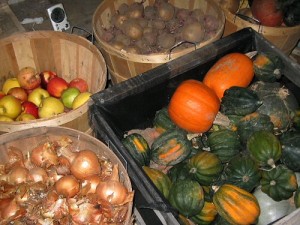 Preserving food has always been a tradition in the fall – gathering the harvest and storing it for sustenance through the long prairie winter. Today, easy access to food transported from warmer climates has made this concept a lost tradition – the food preservation and storage skills, once crucial to our survival, are more of a hobby for enthusiasts or a must-do for those with gardens bigger than their summer stomachs!
Preserving food has always been a tradition in the fall – gathering the harvest and storing it for sustenance through the long prairie winter. Today, easy access to food transported from warmer climates has made this concept a lost tradition – the food preservation and storage skills, once crucial to our survival, are more of a hobby for enthusiasts or a must-do for those with gardens bigger than their summer stomachs!
This trend appears to be reversing, however. Earlier this week there was an article in the Globe and Mail about root cellaring. This got me thinking. I’ve seen more and more books published with instructions on how to put up your summer bounty into jams, jellies, pickles, relishes, salsas and chutneys. Canning workshops abound in community centres, church basements and grandmothers’ kitchens.
We’re lucky to live where we do. Long, warm summer days make harvesting garden vegetables a pleasure. Fall geese provide the soundtrack to storing squash, carrots and potatoes in bags and bins in the root cellar at our family farm. Long, cold winters make keeping frozen foods relatively easy – in plastic bins and buckets on the back porch or in the shed.
Food preservation brings us back to our roots. Literally. It encourages us to eat more locally, and get to know those who grow our food. It shortens the distance our food has to travel, lessening the environmental impact of that transportation. It winds up cheaper, most of the time, to buy food in bulk. It puts us in touch with and encourages us to eat with the seasons. It builds community through seed planting in spring, sharing the first summer cucumber with a neighbour, and giving gifts of pickles and jellies at the holiday season.
Sounds pretty good to me. Are you interested? Check out a root cellaring book from the library. Take a canning workshop. Learn how to love spaghetti squash, sauerkraut and toast with jam. They’re the flavours and tastes of the season, regardless of the time of year.



Trackbacks/Pingbacks